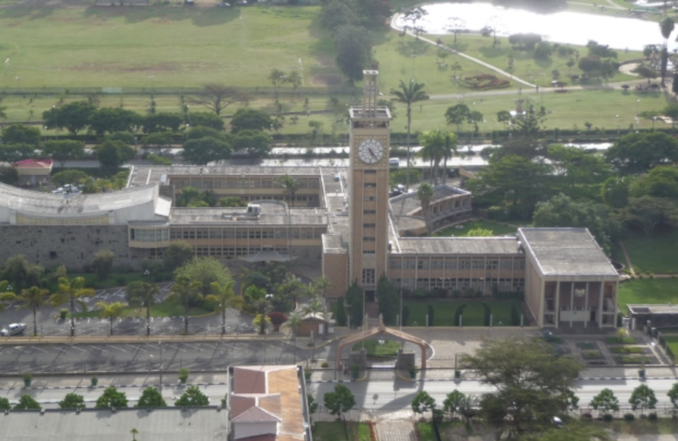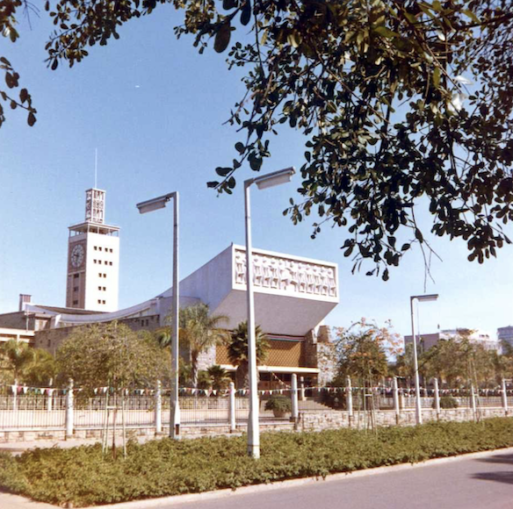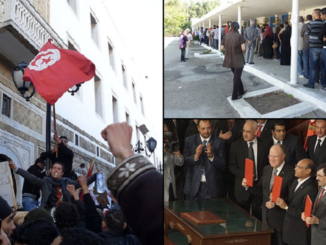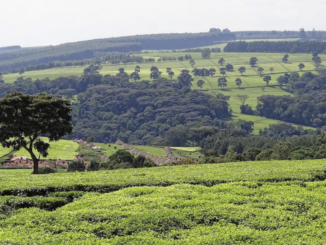
Maasai giraffe, the tallest animal in Kenya with the Britam Tower,
Alexmbogo – Licence CC BY-SA 4.0
Some more on the background context of how Kenya got to where it currently is. The presidential contest election was effectively a two-horse race between Deputy President William Ruto and veteran politician Raila Odinga. Neither proposed a paradigm-shifting break with Kenya’s current neoliberal and neo-patrimonial character. Nevertheless, their agendas were starkly different and each would irreversibly change the country’s trajectory.
Ruto, verbally for Lame stream purposes, proposed returning Kenya to a pre-industrial era, reverting to small-scale informal production and subsistence agriculture, reversing gains the country had made in the past two decades. Raila promised a return to the country’s industrialisation agenda, which took off in the 2000s but floundered under Uhuru administration, with the vision of putting Kenya back on track towards becoming a standard capitalist advanced economy. As always, and like many Western nations, Kenyan elections focused on the heat and light surrounding politicians’ personalities and party dramas, due to total lack of, over one year, any campaigning, except on Kenya TV.
A legacy of colonialism and lost hope
Kenya, is a nation of boundless potential yearning for change in which most people live in poverty while a handful [politically connected via tribe] enjoy obscene wealth. It is a nation of plenty, but one that has repeatedly been betrayed by predatory politicians who abuse the trust bestowed upon them.
This history can be traced back to the British colonial project, which was brutal and repressive as well as racist and parasitic. The colonialists forcefully expropriated Kenya’s rich highlands, creating the agrarian economy whose primary purpose was to supply British industries and kitchens. Meanwhile, unlike in colonies like Australia or New Zealand, the government made no investments in advancing industry or social welfare; education for Kenyan subjects merely imparted crude agricultural skills suitable for an obedient workforce.
In the 1940s, the British developed a new strategy as the possibility of decolonisation loomed. They sought to create a “responsible” middle class that could guarantee their foreign capital investments and head off any potential working class rebellion. Kenyan nationalists were allowed to share power with their colonial masters as a subservient client elite in return for guaranteeing to reproduce colonial structures in the event of independence. They were not however allowed anywhere near the finance. Despite this tactic, a radical independence movement known as the Mau Mau emerged and grew in the 1940s-50s. Kenya was granted independence in 1963.
At independence, the popular national movement Kenyan African National Union (KANU) came to power. It promised to not only liberate Kenya from the yoke of colonialism but free people from the degrading conditions they had been subjected to by imperialism. It vowed to eradicate poverty, disease, and ignorance. Kenyans were extremely excited about the future.
However, their dreams were already dead by the end of the first republic, killed by ethnic chauvinism and corruption perpetrated by a brutal cabal that captured the state. Political elites hijacked the “million-acre scheme”, which was meant to return vacated colonial land to its original owners. The government failed to engage in nation-building. And President Jomo Kenyatta undermined the multi-party system as he centralised power.
KANU’s development agenda meanwhile ended any hopes of socialist economic transformation. Even though the economy grew, it followed the colonial pattern of marginalising large sections of a dependent country that produced what it didn’t consume and consumed what it couldn’t produce.
Kenyatta’s death in 1978 and replacement by Daniel arap Moi brought, very briefly, the possibility of a fresh start. This hope was short-lived too. The country saw the reintroduction of torture chambers, detention without trial, and a reign of terror unleashed on opponents. Tribalism thrived even as Moi preached “peace, love and unity”. Furthermore, the economy collapsed. Kenya had to turn to the failed World Bank/IMF’s structural adjustment programmes (SAPs), which led to de-industrialisation and the decimation of domestic industries as protective fiscal barriers were dismantled to liberalise trade.

Kenyan parliamentarian building, Nairobi,
Rotsee – Licence CC BY-SA 3.0
From new hope to despair
A decades-long bloody struggle for multiparty democracy against Moi’s one-party dictatorship bore fruit in 1992, paving the way for multi-party elections in 1992 and 1997. Moi won both, as nascent opposition parties fractured amid leadership disputes.
In 2002, however, the opposition learned their lessons and formed a broad national front under the National Rainbow Coalition (NARC). Among others, this brought together 1997 presidential candidates Raila Odinga and Mwai Kibaki [Moi’s Finance Minister and the only competent minister Moi had that was respected by the West]. Raila, who had also served as a minister in Moi’s government in 2001-2 before defecting, stepped aside to allow Kibaki to be opposition flag-bearer. The NARC candidate defeated Uhuru Kenyatta, the KANU nominee that Moi had picked to be his successor, in a landslide.
Kibaki was sworn in on another wave of hope. Many believed their new president’s promise that “corruption will cease to be a way of life” and, in 2003, Kenyans were surveyed to be the most hopeful people in the world. Ordinary citizens arrested corrupt policemen and frog-marched them to police stations across the country.
Yet again, Kenyans’ hopes were betrayed. Within months, the ebullient national mood had turned to despair. Impunity and corruption returned as the pillars of politics and public life, as an ethnic cabal known as the “Mount Kenya Mafia” captured the state. In the words of anti-corruption activist John Githongo, this new elite declared: “it is our turn to eat”. The subsequent book of the same title, blacklisted in Kenya, nevertheless reached the top of the book sales charts in Kenya [knowing the way round the system – Red Spot – the book shop at Yaya Centre].
Sir Edward Clay
More famously, the public contributions by former UK Ambassador to Kenya. Clay, who, for a Foreign Office mandarin, is not only a top bloke but the only ambassador I’ve met with whom one didn’t need an appointment. He nearly always ignored “elite weekend cheese and wine parties” and spent his “free” time, together with his wife Anne, in Mathare slum working with Mathare youth sports Association [MYSA] using sport as a tool to help move towards a better life. He kicked Dfid and helped build the slum library.
Edward’s infamous geopolitical kick, at which I was fortunate to be present which flat-lined out the US. Edward regularly delighted Kenyans with such antics.
The morning after a US security alert for Nairobi in December 2003 targeting specific hotels [the Stanley and Norfolk], he took breakfast in both identified by the US as possible targets, saying he considered security quite adequate and walked between each hotel [20-minute walk] with no personal security. He ensured the Kenyan security on the front doors of each hotel, were given a “full English breakfast” and Ksh1,000 bob airtime, at his personal expense at both locations. This was specifically done to ignore the French Ambassador [also heading the EU– Africa drive at the time] who wanted Clay to have breakfast at the French Embassy the same morning.
His infamous speech at the Serena hotel in July 2004 addressing the British Business Association lunch, which he also ensured was published in full by Kenyan newspapers, Edward accused ministers and senior officials in Kibaki’s administration of wide-ranging wrongdoing.
He said:
“It is outrageous to think that corruption accounts for about 8% of Kenya’s GDP. Kenya is not a rich country in terms of oil deposits, diamonds or some other buffer which might featherbed a thoroughgoing culture of corruption. What it chiefly has is its people – their intelligence, work ethic, education, entrepreneurial and other skills.
Those assets will be lost if they are not managed, rewarded and properly led. One day we may wake up at the end of this looting spree to find Kenya’s potential is all behind us and it is a land of lost opportunity.
We never expected corruption to be vanquished overnight. We all recognised that some would be carried over to the new era. We hoped it would not be rammed in our faces. But it has: evidently the practitioners now in government have the arrogance, greed and perhaps a sense of panic to lead them to eat like gluttons. They may expect we shall not see, or will forgive them, a bit of gluttony because they profess to like Oxfam lunches. But they can hardly expect us not to care when their gluttony causes them to vomit all over our shoes; do they really expect us to ignore the lurid and mostly accurate details conveyed in the commendably free media and pursued by a properly-curious Parliament?
Some allegedly sober people have reproached the media for being “sensational”. Such calls for media responsibility are usually a way of covering up threats. The fact is there would have been no disclosure had it not been for the press. It is the truths they have laid bare that are sensational and they need no dressing up.”
Edward, still widely admired by ordinary Kenyans for his colourful outspokenness/honesty about officialdom [hitting both Kenya and UK Governments], said he had been outraged by activities in the government of a country and people for which he felt great affinity.
He had been accused of “interfering in Kenya’s domestic affairs” but he said “the old dragon of corruption” had re-emerged with veiled threats to the media and “real, red-blooded threats to fix, nobble or even damage those who want to investigate the corrupters.”
A list of ministers and senior civil servants who were not corrupt would “fit on a postcard, or possibly a postage stamp”, he said, while a £90 million contract [Anglo Leasing] had been awarded to a shady company “incapable of commissioning a garden shed and discovered never to have delivered anything more than drawings on the back of an envelope.”
The Kenyan government appeared to have been taken aback by the attack. “We urge those who have any evidence of wrongdoing to contact the police,”
Having never been one to back off, in July 2001 Sir Edward was removed as High Commissioner in Cyprus after criticising local people protesting at British radio masts on the island. Local sentiments were inflamed when he described a Cypriot MP who had climbed one of the receivers as “a medical monkey up a stick”.
Failed Draft Constitution 2005
In 2005, Kibaki brought a butchered version of a popular draft constitution to a referendum. Raila fiercely opposed the document, which would have consolidated presidential powers, as did the opposition KANU led by Uhuru and Ruto. When the constitution was defeated, Kibaki ejected Raila and his faction from the cabinet.
This set the stage for the 2007 elections in which Kibaki faced Raila. Kibaki was narrowly declared the winner, but many believed the vote had been manipulated. It was, by UK Government. Raila also claimed victory. Popular demonstrations descended into an orgy of deadly violence in which 1,500 people were killed and 350,000 were displaced. As the security rep for Westlands, trying to contact the UK High Commission proved impossible. All senior staff were at Muthaiga golf course. The only point of accessible contact was Edward Clay, in office, on his own. He got his reports.
Kenya was rescued from full-scale civil war by the signing of the National Accord and Reconciliation Act in 2008. This led to a power-sharing deal in which Raila became PM.
The deal also paved the way for the promulgation of a new 2010 constitution [a diluted copy/paste of the US one], which devolved power and resources from the centre to many hitherto ignored regions in the periphery.
The document also explicitly sought to demand higher ethical standards of Kenyan leaders, though attempts to improve governance by referring to the constitution’s standards had little success. As author Issa Shivji aptly observed: “Constitutions don’t make revolutions. Revolutions make constitutions… Constitutions rarely herald fundamental transformations. They are the product of fundamental transformations”.
Another legacy of the 2007 post-election unrest was an International Criminal Court investigation [at behest of the US] into the alleged architects of the violence. Indictees included Uhuru and Ruto who, aware that holding public office would insulate them from facing trial, joined forces to run against Raila’s Orange Democratic Movement (ODM) in 2013. Amidst claims of vote-rigging facilitated by the infamous Cambridge Analytica, the two were declared winners and took office.
President Uhuru and Deputy President Ruto ran for re-election in 2017, again against Raila. They were declared victors once more, but the Supreme Court nullified the results on the grounds that the electoral commission had overseen a litany of irregularities. When the opposition boycotted the rerun in protest at the electoral commission’s failure to address the problems identified by the court, Uhuru won uncontested.
Kenya was left split down the middle with a president who had legal authority but little popular legitimacy. Some politicians and citizens actively contemplated secession. In a bid to restore calm, Uhuru and Raila held talks that led to a now infamous handshake between the two rivals in 2018. The nation exhaled.
No sooner had the ink dried on their agreement than a new internecine battle emerged between Uhuru and his deputy Ruto. The last four years saw an unseemly public spat unfold between the president and his newfound ally Raila on the one hand, and Ruto on the other.
Uhuru and Ruto
In their almost decade-long rule, Uhuru and Ruto had overseen the most corrupt period in Kenya’s history. Levels of public looting today are so brazen, that perpetrators no longer bother concealing their malfeasance. Billions of dollars have disappeared from public coffers, and the president himself has publicly said that at least Ksh2 billion ($17 million) is lost to corruption every day.
Kenya has taken on unmanageable levels of debt [Western lenders/banks] for phantom projects that have never materialised and paid hugely inflated costs for those that have. Economic Colonialism dressed up as Western Democracy again.
The Uhuru-Ruto administration has also purposefully deindustrialised the economy, decimating local manufacturing and increasing Kenya’s dependence on imports. The education sector has floundered as the government restricted access to universities in favour of “vocational education” aimed at creating a low-skilled working class. Intellectual and professional pursuit and honest work have been shunned in favour of “hustling”, which in practice means self-enrichment through theft of public resources.
The ambition of becoming a middle-income country that feeds her people through high-tech agriculture have been replaced by musings on the merits of small-scale subsistence farming and the glorification of low-tech “wheelbarrows”, which have become the icon and central campaign promise of Ruto’s presidential bid.
Where Kenyans saw themselves as beacons leading the rest of the continent towards economic nirvana, Kenyans are now being sold primitivity and ignorance as aspirational.

Kenyan parliament in Nairobi,
mwanasimba – Licence CC BY-SA 2.0
The choice Kenya Face[d]
This was the backdrop of the 9th August elections and how Kenyans reached that point. Once again, Kenyans were given a choice between two familiar faces at the ballot box no one wanted, endorsed or supported, each with a very different vision.
Ruto
Ruto, self-designated campaign title as “hustler-in-chief”, romanticises ignorance and poverty to advance a cynical class warfare agenda. He advocates “bottom-up economics”, which when interrogated mainly promised sustained deindustrialisation. His vision echoed both the colonialists’ plan for the indigenous population and Kenyatta and Moi’s deliberate suppression of Kenya’s advancement to ensure a subservient populace.
Ruto’s agenda left many questions unanswered. What did it mean for the average Kenyan? How can a country of 50 million feed itself on subsistence farming? What does it mean to create a low-skilled “hustler” working class who can’t respond to increasing global demands for technical skills and automation? How can a country without industry compete in a world in which other countries are aiming for self-sufficiency?
Raila
Raila’s ten-point verbal manifesto built from a vision of Kenyan life transcendent from the brutality of poverty and ignorance. It aimed to reinvigorate and safeguard industry to produce for Kenyans and gain global competitive advantage. Raila promised universal healthcare, and his campaign’s central feature was an ambitious social welfare programme for the indigent. His verbal manifesto attempted to break Kenya away from a path of dependency shaped by its colonial origins. It attempted to right the wrongs of the past and present to help Kenya leapfrog into an advanced future.
Kenya reached its latest crossroads in August. After decades of betrayed promises, elections offered to provide another opportunity for citizens to mobilise a movement for a new more equal Kenya. In vain.
Result Manipulation
Kenya’s current population c/o Kenya Government census taken in May 2021 is circa 56.8m. Those over 18, with ID cards and legally registered to vote is 54.2m.
With a minimal turnout on 9th August 2022 [27%], results counted, verified at polling stations, everyone knew countrywide no clear winner, either way for President. Other minor positions [Governor, MCA, MPs etc were announced locally]. According to the IEBC, circa 15m [27%] voted but only they would validate counts according to various signed, stamped forms submitted along with voting boxes [taken as manipulated – recount] so IEBC could “validate”.
Since inception in 2011 [funded/controlled by US and UK Governments], the IEBC’s problems have never been resolved: they are inherent in the nature of the organisation itself, essential to its functioning.
Kenyans are fully aware of this. During the supposed tallying count, given at the time, neither Raila [49.7%] or Ruto [49.4%] were able to bypass the imaginary number of 50% +1 vote of 27% who voted. The IEBC were back in a hole of their own making and no way out.
With each county having already known their real position, IEBC still couldn’t get round their own problem and were unable to declare any winner.
From 11th August, Presidential tallies disappeared off Kenya TV.
The IEBC was back in familiar territory delaying reality to attempt to engineer a clear winner, aside the obvious 39.2m [73%] of the population refused to vote, therein election null and void under democracy. IEBC’s attempts to manufacture a winner using battalions of staff to repeat counts, what was undertaken locally to validate signed and approved; stamped forms of counts went nowhere. Off to court.
Enter Mark Malloch Brown and Smartmatic
Malloch Brown, chairman of the board of directors of SGO Corporation Limited, a holding company whose primary asset is the election technology and voting machine manufacturer Smartmatic. Malloch Brown, a Blair coterie wormed his way up the corrupt ladder.
Smartmatic
Smartmatic having rigged results in the US, Venezuela was supposed to be trialled in the 2021 Uganda elections. However, Musaveni [M7] refused them entry into the country and also blocked all US vote monitors and many reporters. So, they came to Kenya.
IEBC [on US/UK orders] awarded Smartmatic a Sh4 contract to supply and maintain the Kenya Integrated Election Management System (KIEMS) kits used as voter identification devises and relaying of electronic results forms to polling centres. However, the results rigging exercise didn’t go according to plan. The end result was the Supreme Court, which follows the template of UK law, it’s members already bought off, deemed that releasing full access to Smartmatic’s servers would violate its intellectual property rights, aka profits.
Kenya’s final election result 2022.
15 August. IEBC since 8am were stating the final result will be officially announced at 3pm. Of course, nothing happened until 5.30pm. As usual, IEBC simply announced and gave percentages of vote split for “President” – Ruto 50.49% Raila 48.85% then declaring winner re President “Elect”.
Vote counting tally [IEBC number juggling] eventually released: Ruto: 7,176,141, Raila 6,942,930
On 7th Nov, Ruto and Niknak met at COP 27 and UK deal which props up Ruto’s Government In Name Only.
Footnotes
Cambridge Analytica poisons Kenya’s democracy
© AW Kamau 2023



